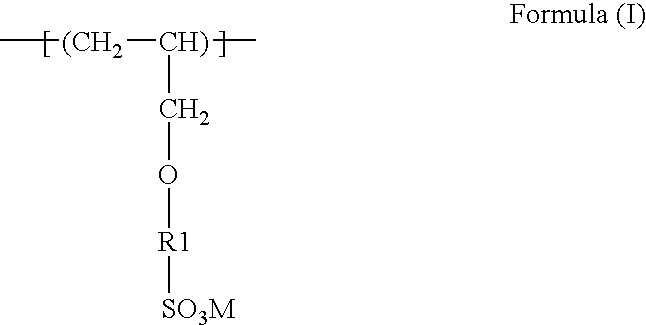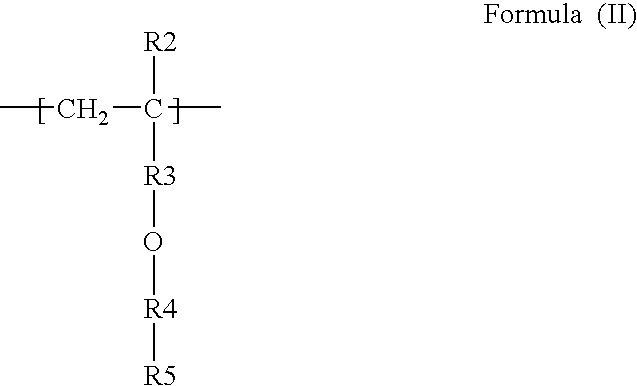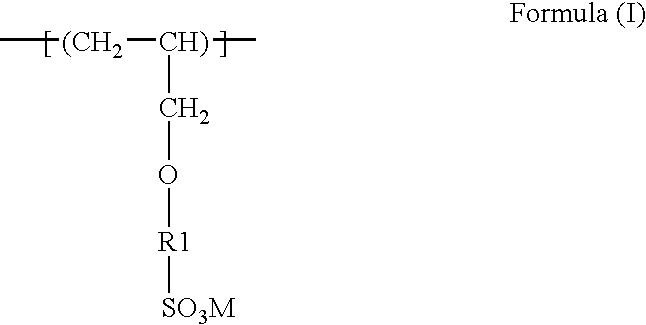Cement dispersant and methods of making and using the same
a technology of cement dispersant and dispersant, which is applied in the field of cement dispersant and methods of making and using the same, can solve the problems of reducing the slump, affecting the quality of cement, and slump loss still persisting in the field, so as to improve the life of the slump and reduce the effect of water
- Summary
- Abstract
- Description
- Claims
- Application Information
AI Technical Summary
Benefits of technology
Problems solved by technology
Method used
Image
Examples
example 1
[0020] Sample 1
[0021] A suitable flask was equipped with a condenser, an addition funnel, a mechanical stirrer, a thermometer and a nitrogen sparger. The flask was charged with 46.3 g (0.075 mole @ 95%) of APES-10 and 90 g of deionized water. 16.2 g (0.225 mole @ 99%) of AA was charged to a 20 cc syringe and placed on a syringe pump. 9.12 g of a 16.6% solution of sodium persulfate (“initiator solution”) was charged to a separate syringe and placed on a separate syringe pump. The aqueous APES-10 solution was sparged with nitrogen and heated to 85° C. The M and the initiator solution were pumped into to the aqueous APES-10 solution simultaneously over three hours. The resulting aqueous copolymer solution was heated for one more hour at 85° C. then cooled to room temperature. Caustic (50%) was then added to adjust the pH to 6.4. The resulting copolymerization product, acrylic acid / allyloxypolyethylene glycol sulfate ammonium salt (“AA / APES-10”), was in the form of a clear, light yello...
example 2
[0029] Each of the samples of dispersants produced in Example 1 was tested for slump efficacy using the Cement Mini-slump testing procedure known as the “Standard Test Method for Slump of Hydraulic Cement Concrete” ASTM C143-97, Vol. 04.02, which is hereby incorporated by reference in its entirety. Additional information regarding the Cement Mini-slump test is found in D. L. Kantro's, Influence of Water-Reducing Admixtures on Properties of Cement Paste—A Miniature Slump Test, Cement, Concrete and Aggregates, 2, (1980) pp. 95-102, the entire contents of which is hereby incorporated by reference. Specifically, 100 grams (g) of Type 1 Portland cement was added to a disposable beaker. 35 g water was added to the beaker and the cement and water was mixed for 30 seconds with a metal spatula to produce a slurry. 0.32 weight percent of each of the samples produced in Example 1 was dosed via a disposable syringe into the cement slurry. The slurry was mixed for an additional 30 seconds. The c...
example 3
[0030] Each of the samples of dispersants produced in Example 1 was tested for slump efficacy using the same procedure as in Example 2, except that 0.20 weight percent of each of the samples produced in Example 1 was dosed via a disposable syringe into the cement slurry. The results of Mini-slump Testing using Samples 1-26 produced in Example 1 is shown in Table 4 below.
TABLE 4Slump Diameter (cm)SampleDispersant %0 min30 min60 min90 min120 min10.2017.7ThickThickThickThick20.2018.2ThickThickThickThick30.2017.312.812.512.011.240.2020.911.4ThickThickThick50.2017.8 9.4ThickThickThick60.20ThickThickThickThickThick70.2013.2ThickThickThickThick80.2016.014.013.413.312.690.2015.813.713.212.912.2100.2020.511.710.6 9.5 7.6110.2020.2ThickThickThickThick120.2013.5ThickThickThickThick130.2016.9ThickThickThickThick140.2017.6ThickThickThickThick150.2019.212.512.211.610.3160.2015.013.012.812.211.6170.2016.914.114.013.513.1180.2018.2 8.0ThickThickThick190.2013.5ThickThickThickThick200.2020.617.917....
PUM
| Property | Measurement | Unit |
|---|---|---|
| temperature | aaaaa | aaaaa |
| weight percent | aaaaa | aaaaa |
| water-soluble | aaaaa | aaaaa |
Abstract
Description
Claims
Application Information
 Login to View More
Login to View More - R&D
- Intellectual Property
- Life Sciences
- Materials
- Tech Scout
- Unparalleled Data Quality
- Higher Quality Content
- 60% Fewer Hallucinations
Browse by: Latest US Patents, China's latest patents, Technical Efficacy Thesaurus, Application Domain, Technology Topic, Popular Technical Reports.
© 2025 PatSnap. All rights reserved.Legal|Privacy policy|Modern Slavery Act Transparency Statement|Sitemap|About US| Contact US: help@patsnap.com



